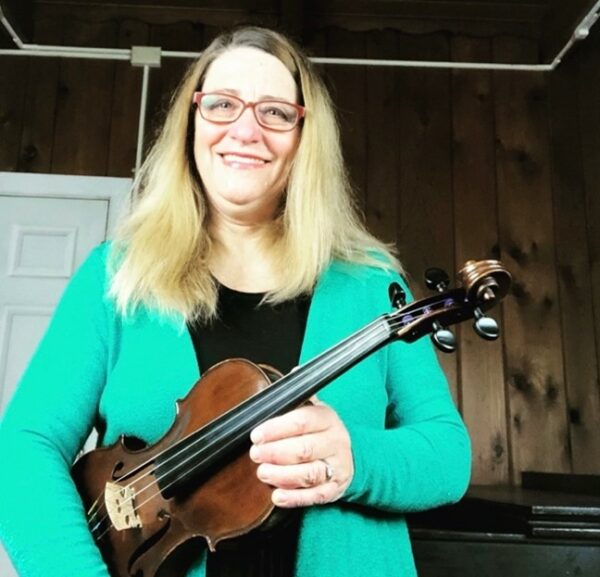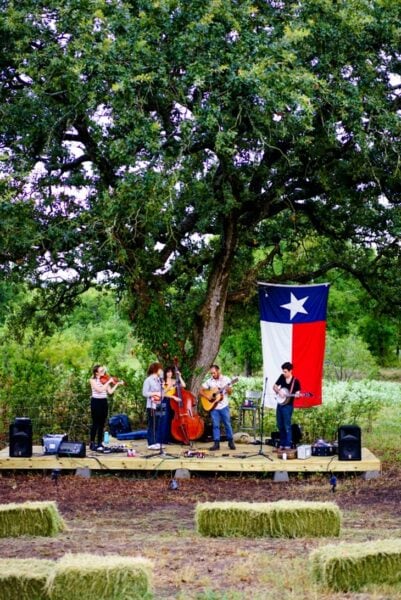/ News Posts / Flexible Fiddling Leads to Increased Engagement in Orchestra
Flexible Fiddling Leads to Increased Engagement in Orchestra
By NAfME Retired Member Jenny B. Peters
Recently I decided to learn to fiddle. I wanted to play by ear and improvise. I had played fiddle tunes off printed music. But I wanted to have more insights into the history and style of this music. And I wanted to pass this music on to my students.
So, I attended bluegrass jam circles at farmer’s markets and music stores to learn how.
A bluegrass jam is typically a circle. Everyone in the circle takes turns choosing the next song. This usually goes in a clockwise direction. When it’s your turn, you can pick a song or pass the privilege along to the next person if you don’t have one in mind.—Erik Rolfsen
The other musicians are accommodating and pass along the etiquette of the circle. Sometimes it’s the fiddles’ turn for melody. Sometimes you play a more complicated break. Sometimes you play back-up. If someone is singing or another instrument is taking the lead, you play more quietly.
So how did the students react?
They LOVE these tunes. And they are teaching them to each other.
Students have taken part in the arranging process too. The violists and bassists requested the melody. So I rearranged the music to fit the needs and abilities of my students.
How has Flexible Fiddling helped students?
- Students are motivated.
- Students are playing together and listening to each other.
- Students are reading music with ease.
- Students are creating their own music.
- All students are successful.
Students Are Motivated
Students like this music. They can find these tunes on YouTube and Spotify. They are playing “real” folk music. They are inspired to practice and get it right. Students learn partly by ear. They can play more complicated rhythms and melodies than their note and rhythmic reading abilities would allow. They then are motivated to learn how to read what they can play.
Students Are Playing Together and Listening to Each Other
Students use backup tracks as they learn the songs. This helps with the more complicated rhythms. They have to fit the rhythms into the beat structure. When I turn off the backup tracks, students listen across the orchestra and stay together. They know when their part is important and when it is an accompanying part. They are able to adjust their dynamics according to the needs of the music.
Students Are Reading Music with Ease
Students learn the Building Blocks in unison. The way the stronger players pull the less experienced players along. The Building Blocks also have note names inside the note heads, which reinforces reading. Then, when students play the Orchestra Arrangement, they recognize what to play—melody, bass line, or backup. As one student said, “You don’t need the notes written in on the Orchestra Arrangement page. Because it’s the exact same thing!” One page has scaffolding, and one does not. Students develop note-reading abilities.
Students Are Creating Their Own Music
Flexible Fiddling encourages students to improvise with improvisation prompts. Students learn to change the song a little bit, something called a micro-improvisation. As they become more comfortable with this idea, they are reaching out to me with songs they have written. They realize that creativity in music is something open to everyone and that if you work with it and play with it, you get better.
All Students Are Successful
When parts are too hard or too easy, it’s possible to change them. Students know the backup and bass line. There are some first-year players in a third-year group. These students can play a part that stays out of the way of the more experienced players. I have two or three new beginners in the orchestra this year. I’ve given them simpler parts so they can still be part of the experience. They are playing the part they can play, not faking the part they can’t play.
Flexible Fiddling has exceeded my expectations. I am thrilled I wrote this out for students at this early level in their playing. They will always remember how much fun they had making music!

 NAfME retired member Jenny B. Peters’s mission is to guide people to find their inner musical selves. She is a sought-after clinician, composer, and creative musician. She composes music, offers music courses, and teaches privately.
NAfME retired member Jenny B. Peters’s mission is to guide people to find their inner musical selves. She is a sought-after clinician, composer, and creative musician. She composes music, offers music courses, and teaches privately.
Jenny composes and arranges for string orchestras. She teaches piano, violin, viola, ukulele, and improvisation from her home studio. She is an accompanist and chamber-music coach.
Many of Jenny’s former students have gone on to successful music careers. Jenny’s main joy is in teaching people from diverse backgrounds to love music. Whether it’s violin, viola, ukulele, or piano, Jenny delights in showing students how music works. And how they can improve at music when they put in the effort.
Jenny and her sister, Rebecca Bogart, created the unique pedagogy of Ukulele for All, released by Kjos Publishing. Jenny and Rebecca are also the authors of the Amazon best-selling 21 Songs in 6 Days series of ukulele books. Jenny is a popular YouTube ukulele personality. She is a sought-after clinician for music educators in learning to teach ukulele. She has been a guest clinician for All-State Music Educator Conferences in Illinois and Arizona.
Jenny recently retired from a successful public school orchestra program in Skokie, Illinois. Before that she taught Elementary General Music for ten years. She has served on the faculties of Lake Forest College and the College of Lake County. She taught piano, violin, and chamber music at the Music Institute of Chicago.
Jenny holds a Master of Music in Piano Performance from the University of Illinois. She holds a Bachelor of Music in Piano Performance from the University of Washington. She earned her teacher’s certification from Trinity International University. These educational credentials allow her to share her passion for music with students of all backgrounds.
Did this blog spur new ideas for your music program? Share them on Amplify! Interested in reprinting this article? Please review the reprint guidelines.
The National Association for Music Education (NAfME) provides a number of forums for the sharing of information and opinion, including blogs and postings on our website, articles and columns in our magazines and journals, and postings to our Amplify member portal. Unless specifically noted, the views expressed in these media do not necessarily represent the policy or views of the Association, its officers, or its employees.
Published Date
November 16, 2023
Category
- Repertoire
Copyright
November 16, 2023. © National Association for Music Education (NAfME.org)






